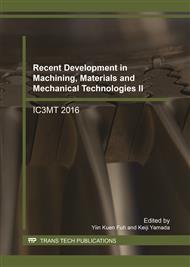p.3
p.9
p.15
p.21
p.27
p.33
p.39
p.46
Roller Burnishing Method with Active Rotation Tool - Better Surface Finish than Conventional Roller Burnishing
Abstract:
This paper proposes a roller burnishing method that controls the sliding direction of the burnishing tool on the surface of cylindrical workpiece. In this study, the sliding direction was set by inclining the axis of the burnishing tool with respect to the axis of the workpiece and by actively rotating the roller of the burnishing tool. The workpiece was a cylindrical aluminum alloy bar, which was rotated in a bench lathe. The burnished surfaces at several sliding angles between 15º and 90º were evaluated. The sliding direction, which is set according to a theoretical equation, was experimentally obtained for every sliding angle in the range of 15-90º with respect to the circumferential direction of the workpiece. The sectional profile was flattened and surface roughness was decreased with increasing sliding angle. As a result, the burnished surfaces obtained in this work were superior to those obtained in an earlier study by the authors, in which the burnishing tool was not actively rotated.
Info:
Periodical:
Pages:
9-14
Citation:
Online since:
August 2017
Authors:
Keywords:
Price:
Сopyright:
© 2017 Trans Tech Publications Ltd. All Rights Reserved
Share:
Citation:


